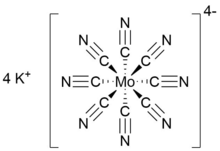Potassium octacyanomolybdate(IV)

| |

| |
| Names | |
|---|---|
| IUPAC name
Potassium octacyanidomolybdate(IV)
| |
| Other names
Potassium octacyanomolybdate(IV)
| |
| Identifiers | |
| |
3D model (JSmol)
|
|
PubChem CID
|
|
| |
| |
| Properties | |
| K4[Mo(CN)8] | |
| Molar mass | 460,47 g/mol (anhydrous) 496.5 g/mol (dihydrate) |
| Appearance | yellow powder |
| Melting point | >300 °C |
| Hazards | |
| GHS labelling: | |

| |
| Warning | |
| H302, H315, H319, H335 | |
| P261, P305+P351+P338 | |
Except where otherwise noted, data are given for materials in their standard state (at 25 °C [77 °F], 100 kPa).
| |
Potassium octacyanomolybdate(IV) is the inorganic salt with the formula K4[Mo(CN)8]. A yellow solid, it is the potassium salt of the homoleptic cyanometalate with the coordination number eight. The complex anion consists of a molybdenum cation in the oxidation state IV and eight anionic cyanide ligands resulting in an overall charge of -4, which is balanced with four potassium cations. K4[Mo(CN)8] is often prepared as its dihydrate.
Preparation
The dihydrate K4[Mo(CN)8] · 2 H2O can be prepared by the reduction of molybdate (MoO42-) with potassium borohydride (KBH4) in a solution with potassium cyanide and acetic acid.[1] This was one of the first syntheses, where the molybdate is reduced at the same time as the cyanometalate is formed. The yield is typically about 70%. This method is applicable to big batches, because the work-up is more efficient at large scale and the starting materials are inexpensive.
4 MoO42- + 32 CN- + BH4- + 31 H+ → 4 [Mo(CN)8]4- + 16 H2O + H3BO3
Molybdenum has a high affinity towards oxygen. To avoid the energy-consuming molybdenum-oxygen bond cleavage, an alternative route to the potassium octacyanomolybdate(IV) dihydrate starts from MoCl4(Et2O)2 directly from the oxidation state IV, so no reduction is required. The yield of this route is typically around 70%.[2] This synthesis is convenient for lower batch sizes than the earlier method but the MoCl4(Et2O)2 is typically less available than the molybdate.
MoCl4(Et2O)2 + 8 KCN → K4[Mo(CN)8] + 4 KCl + 2 Et2O
Redox Chemistry
One electron oxidation of the octacyanomolybdate(IV) leads to the paramagnetic octacyanomolybdate(V), which is a 17-electron complex used in magnetochemistry.
Reactions
Protonation of [Mo(CN)8]4- in strong acids leads to the homoleptic hydrogen isocyanide complex [Mo(CNH)8]4+, in common with many cyanometalate complexes.[3] These ligands can be substituted by others, for example H2O.
References
- ^ J. G. Leipoldt, L. D. C. Bok,P. J. Cilliers, "The preparation of Potassium OctacyanomolybdateIV) Dihydrate", Z. anorg. allg. Chem., 1974, volume 409, pp. 343-44.doi:10.1002/zaac.19744090310
- ^ G. Handzlik, M. Magott, B. Sielucka, D. Pinkowicz, "Alternative Synthetic Route to Potassium Octacyanidoniobate(IV) and its Molybdenum Congener", Eur. J. Inorg. Chem., 2016, pp. 4872-77.doi:10.1002/ejic.201600669
- ^ M. Sellin, V. Marvaud, M. Malischewski, "Isolation and Structural Characterization of Eightfold Protonated Octacyanometalates [M(CNH)8]4+ (M=MoIV, WIV) from Superacids", Angew. Chem. Int. Ed., 2020 volume 59, pp. 10519-10522.doi:10.1002/anie.202002366
